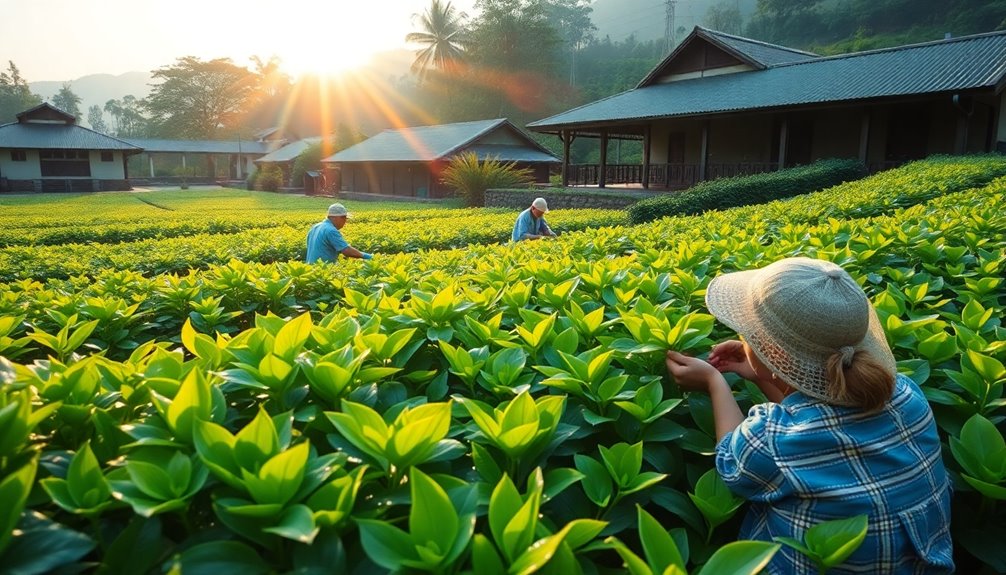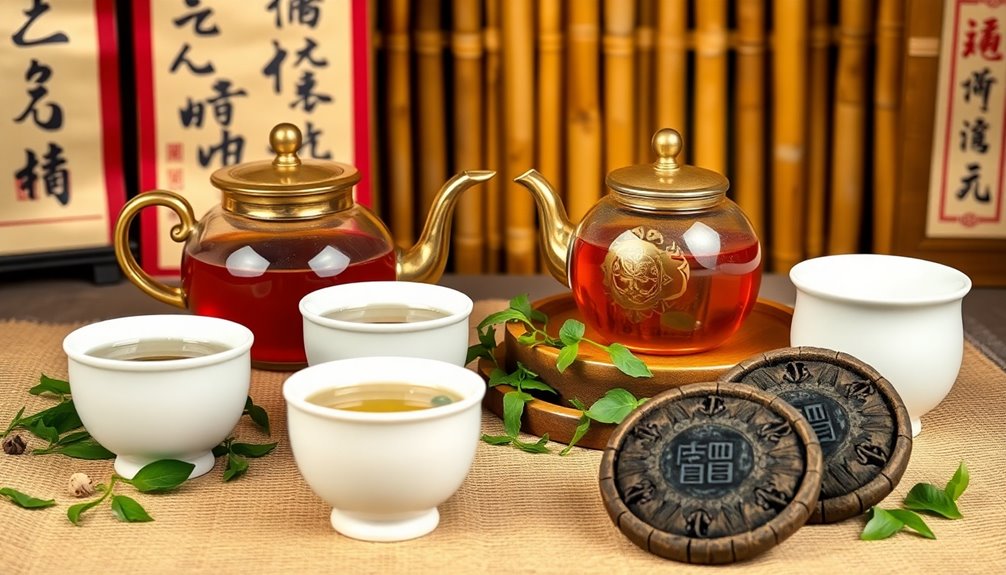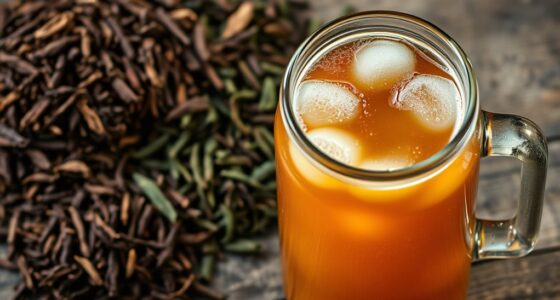The science behind modern tea processing is a blend of old traditions and new technology that creates tasty drinks we love. It all starts with oxidation, which changes certain compounds and affects flavor. Innovative machinery helps make the process faster while keeping the tea's goodness intact. Controlled environments during withering and drying lock in those delicious flavors. You might even find unique teas like kombucha that use special fermentation techniques! Quality checks ensure every sip is delightful and nutritious. Isn't it exciting? Stick around to uncover even more amazing facts about your favorite beverage!
Key Takeaways
- Modern tea processing combines traditional methods with innovative machinery to enhance quality and efficiency.
- Controlled environments during withering and drying lock in desired flavors and maintain chemical composition.
- Enzymatic reactions, particularly through polyphenol oxidase, significantly influence flavor development in various tea types.
- Innovative fermentation techniques, including rapid aging technology, optimize flavor profiles and health benefits of teas.
- Quality control measures, such as chromatography and green analytical techniques, ensure consistency in flavor and nutritional value.
Introduction
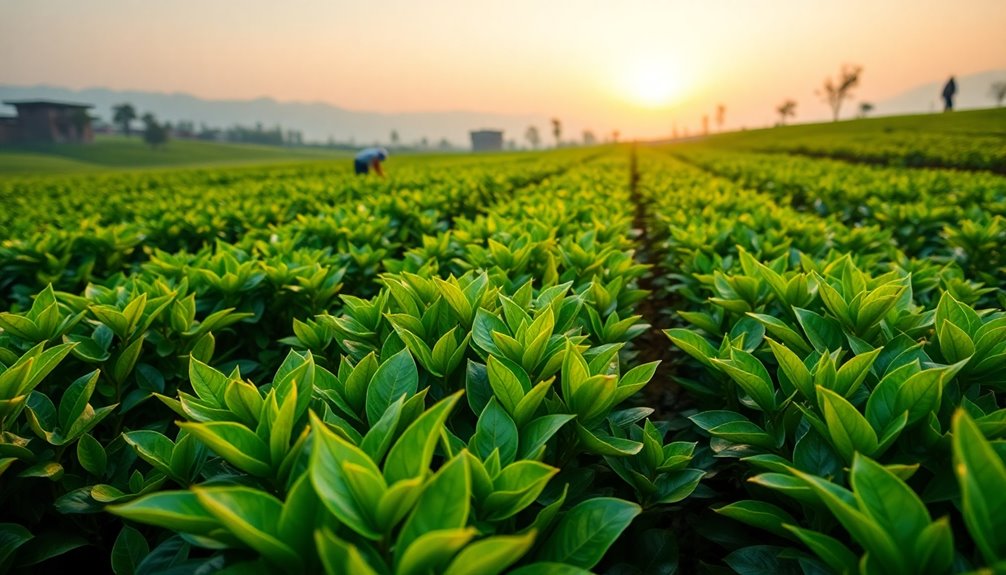
Modern tea processing is a fascinating blend of tradition and innovation, where techniques have transformed over the years. You might be surprised to learn how much science goes into making quality tea! Every step, from withering to rolling and drying, plays a crucial role in shaping the flavor profiles you enjoy in your cup.
One key process is oxidation. This exciting stage changes catechins, the natural compounds in tea leaves, into tannins. This transformation is what gives black tea its rich color and bold taste.
The beauty of modern tea processing lies in its ability to combine traditional methods with new technologies. For instance, innovative machinery helps enhance efficiency and maintain the tea's chemical composition.
The tea industry also focuses on controlled environments, like specific temperatures and humidity levels, during withering and drying. This careful attention ensures that the desired flavors are locked in.
With advancements like hydraulic compacting machines and infrared scanning for stem removal, tea production methods have never been better. So, next time you sip your favorite brew, remember the fascinating journey it took from leaf to cup!
Tea's Historical Processing Methods
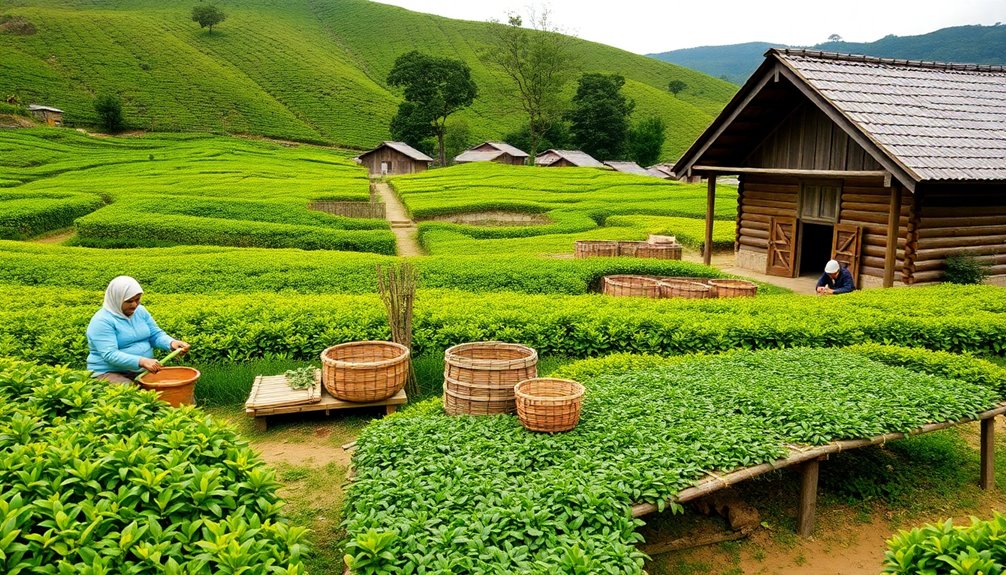
How did tea processing evolve over the centuries? It all started in Southwest China, Indo-Burma, and Tibet. Initially, tea was used as a medicinal herb, but during the Tang dynasty (618-907 AD), it became a popular beverage. This period laid the groundwork for traditional processing methods still used today.
You'll find that there are six major types of tea: green, black, white, oolong, yellow, and pu-erh. Each type requires distinct processing steps. For example, green tea focuses on minimal oxidation, while black tea goes through a full oxidation process. These traditional methods, like withering, fixation, and rolling, are crucial for creating the quality of tea we enjoy.
As times changed, so did tea processing. Modern practices have introduced mechanized processes, especially in places like Taiwan, boosting production efficiency without sacrificing quality.
This blend of traditional and modern methods shows how tea has evolved. So, whether you're sipping a refreshing cup of green tea or a bold black tea, you can appreciate the rich history and careful craftsmanship behind each sip!
Enzymatic Effects on Flavor Profiles
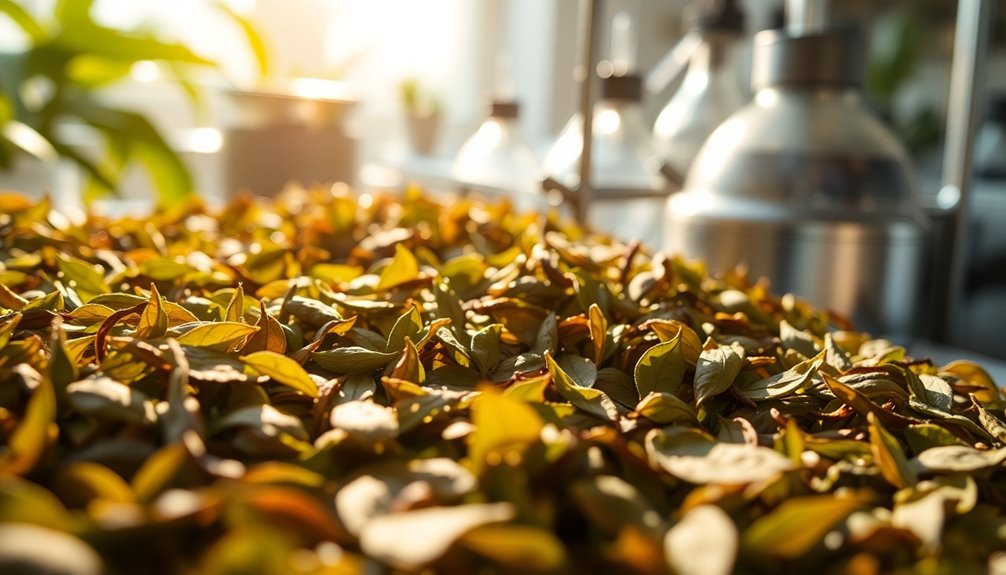
Tea processing is a fascinating interplay of art and science, particularly when it comes to the role of enzymes in crafting flavor profiles. Enzymatic activity, especially from polyphenol oxidase, plays a key role in this journey. It helps oxidize catechins, which are important compounds in tea. This oxidation transforms the flavor profile, giving black and oolong teas their rich, complex tastes.
When you sip a cup of black tea, you can really appreciate how the degree of oxidation affects the balance of polyphenols and tannins. This balance influences the tea's astringency and mouthfeel, making each sip unique.
In contrast, green tea processing uses a fixation method to stop enzymatic activity, keeping those fresh, grassy flavors intact.
Enzymatic reactions during withering and rolling also enhance aromatic compounds. This improvement boosts the overall sensory experience of your tea.
Plus, some tea producers add exogenous enzymes to refine flavor stability, making the tea even more appealing. So, next time you enjoy a cup, think about the incredible science behind those delightful flavors!
Innovative Fermentation Techniques
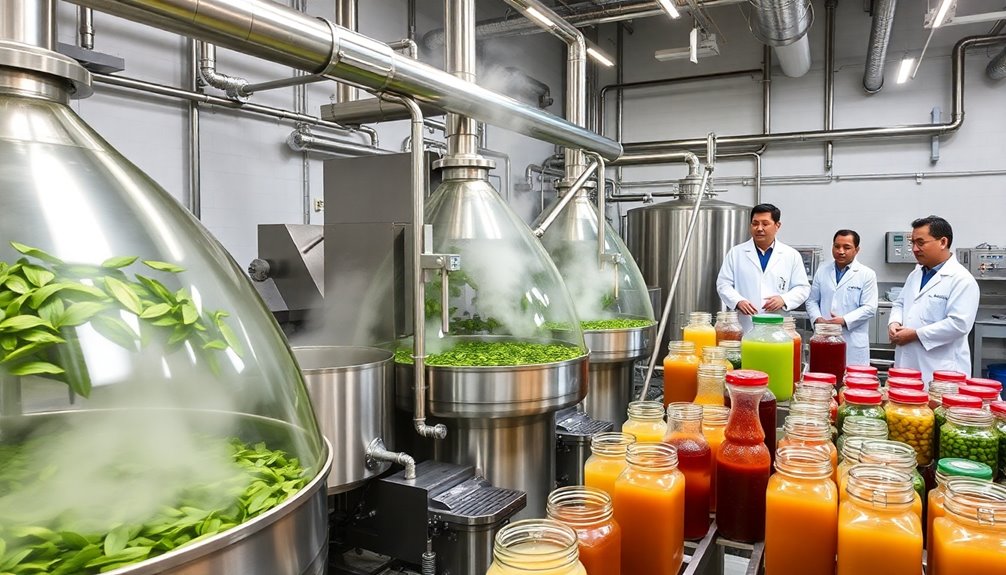
In recent years, innovative fermentation techniques have taken center stage in tea processing, transforming the way you experience flavor and aroma.
Fermented teas, like kombucha, showcase the magic of diverse microbial cultures that enhance their unique flavor profiles. These cultures work during specific fermentation processes, allowing the tea to develop exciting tastes and smells.
Rapid aging technology is another exciting advancement! It helps improve aroma quality by creating controlled fermentation conditions that mimic natural aging. Studies show that these fermentation conditions can boost the antioxidant properties of tea, which means you get even more health benefits from each sip.
Modern equipment plays a big role, too. Tools like infrared scanning help with quality control during the fermentation process, making it easier to keep the tea's integrity intact.
Ongoing research focuses on optimizing fermentation times and choosing the best microbial strains. This ensures that every batch of tea has consistent quality, flavor, and health benefits.
Quality Control in Tea Processing
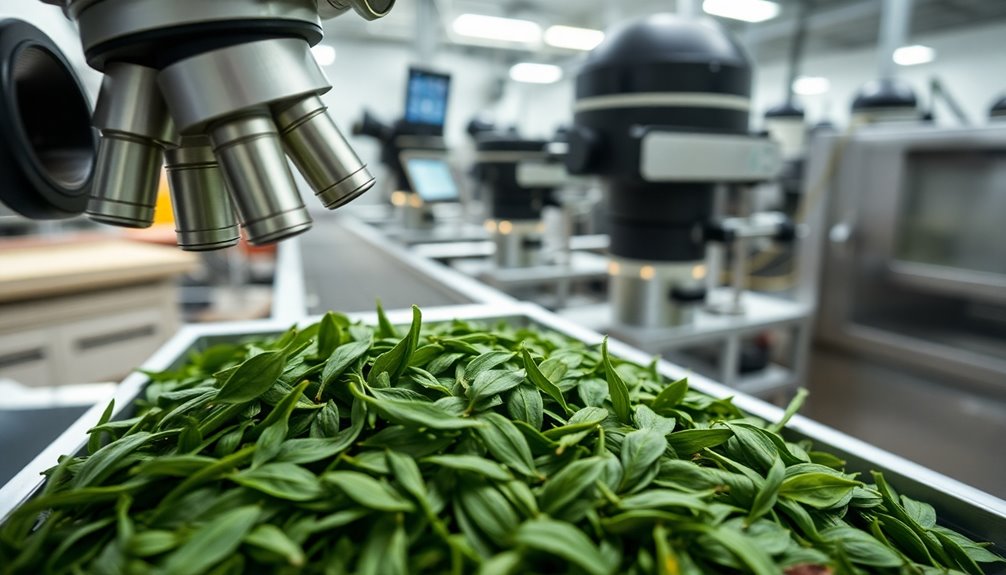
Maintaining high standards in tea processing is crucial for delivering quality products to consumers. You mightn't know, but quality control plays a big role in ensuring that every cup of tea tastes great and is safe to drink. Techniques like chromatography help check the chemical composition of tea. This means you can enjoy a delicious cup of Ziyang green tea, knowing its quality is monitored closely.
During tea processing, enzymes can be added to improve flavor and stability. This enhances the sensory attributes of your favorite beverages, making each sip a delightful experience. Regular monitoring is essential to keep everything consistent, especially when it comes to flavor and quality.
There are also green analytical techniques, like total reflection X-ray fluorescence, that help assess the nutritional value of tea. By using these methods, producers can ensure that the tea you enjoy isn't only tasty but also packed with beneficial nutrients.
Practical Applications
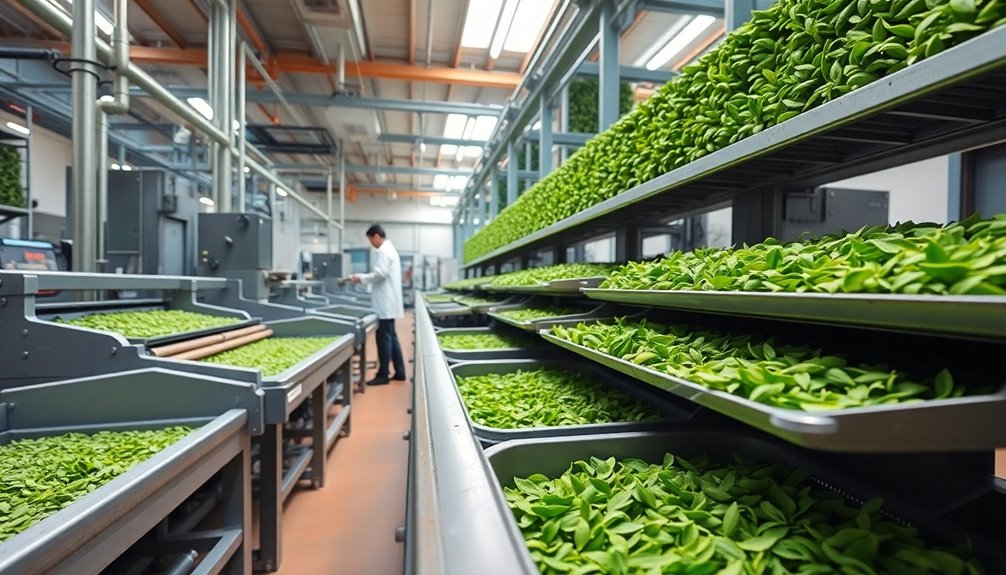
Quality control leads naturally to practical applications that enhance both efficiency and the overall tea experience.
Modern tea processing uses mechanized techniques, like hydraulic compacting machines, that save time while keeping the leaves intact, especially in Oolong tea production. This means you get better quality teas without the extra labor!
Innovative drying methods, such as conveyor belt dryers and controlled temperature roasters, help achieve moisture reduction. This keeps the tea fresh and flavorful.
Plus, infrared scanning makes it easier to remove stems, which improves quality and cuts down on manual labor costs.
For those who love instant teas, cold-extraction processes make them super convenient without losing nutritional quality. You can enjoy a cup of tea quickly and still get the benefits!
Frequently Asked Questions
What Is the Science Behind Tea-Making?
Tea-making involves several key processes, including oxidation, rolling, and drying. Each step influences the flavor and chemical makeup, creating distinct varieties. You'll discover how these methods shape your favorite cup of tea.
How Does Technology Help in Tea Manufacturing Process?
Technology streamlines tea manufacturing by automating processes like withering and drying, ensuring consistent quality. Advanced machines enhance efficiency, while tools like infrared scanning and chromatography maintain flavor integrity and authenticity, elevating your tea experience.
What Is the Science Behind Steeping Tea?
When you steep tea, you're extracting flavors and health benefits. The right temperature, steeping time, and tea-to-water ratio are crucial. Experimenting with these factors helps you discover your perfect brew and enhances your tea experience.
What Is the Process of Tea Processing?
Tea processing involves several steps: withering reduces moisture, oxidation transforms flavors, fixation stops oxidation, rolling shapes leaves, and drying stabilizes the tea. Each step impacts the final flavor and quality you'll enjoy in your brew.
Conclusion
Tea processing is a fascinating journey that combines science and tradition. From the way leaves are dried to the special fermentation techniques, every step matters. You can taste the care in each sip! Understanding these processes helps you appreciate your favorite tea even more. So, next time you enjoy a warm cup, remember the amazing work that goes into it. Dive into this world of flavors and discover how much joy a simple cup of tea can bring!

